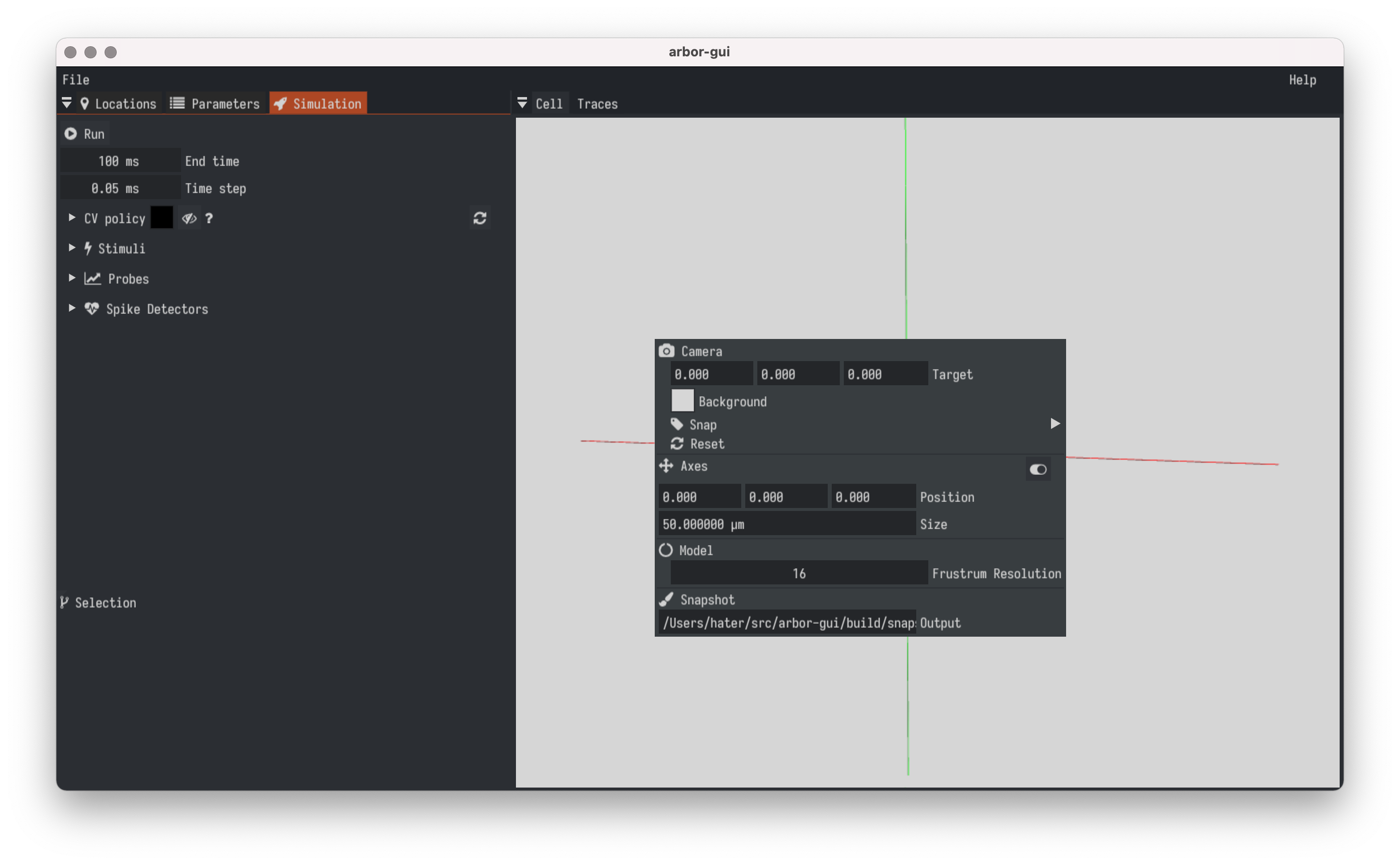-
Notifications
You must be signed in to change notification settings - Fork 61
Single Modelling with Arbor's GUI
Here we will show you how to re-create the first Arbor tutorial in the GUI.
Download one of the binary installers found on the releases page. This guide was written with this build on a MacBook.
Start the GUI and you should see a window like this:

As we need a morphology that can be loaded from disk for use in the GUI, we will make a very simple SWC file:
1 1 -3.0 0.0 0.0 3 -1
2 1 3.0 0.0 0.0 3 1
This sets up a cell consisting of a soma with radius 3 μm, extending 6 μm along the
x-axis. If you are unfamiliar with SWC, do not worry, this is all we
need to do with it. Store this data as eg soma.swc.
Now we need to load this file. In the GUI:
- click on 'File' in the top left:

- choose 'Morphology > Load'
- navigate to your file using the dialogue:

- pick your file and click 'Load'
- if your file is among many others, you can filter for the
.swcextension only by choosing that suffix in 'Filter' - SWC data has multiple interpretations; here we use the 'Neuron' flavor
- go to the cell tab and take a look at your cell in 3D
- mouse wheel and +/- zoom the view
- pressing Shift brings up a rotation handle
- pressing Ctrl brings up a translation handle
- right click the cell tab to
- reset the camera
- manipulate the axes cross
- save a screenshot
- tweak the model rendering resolution, might help performance in complex views
- hover segments to learn some details about the geometry
E.g.:


Now we are ready to continue work on the tutorial by setting up regions and locsets. On the left pane switch to the 'Locations' and expand the 'Regions' and 'Locset' All regions we need are defined, as we just have made a simple soma-only cell.
To attach stimuli and probes we will need a location set, or 'locset'. Click on the '+' right of 'Locsets' to add one.
Type in the following definition in the text box
(location 0 0.5)
Keep track of the status icon changing state from ❔ (empty) over 
The locset we just defined designates the center (0.5) of segment 0. Segment 0 happens
to be the soma. We can assign names to locsets to remember their use or definition.
So, change the name from 'Locset 0' to 'midpoint'. When done zoom in on the cell
to see a marker at the locset point(s).

Note: If you have defined overlapping regions and locsets you can drag the definitions to reorder them. That will change rendering order accordingly and allow you to see hidden parts.
We are now done with 'Locations'. Switch to the 'Parameters' tab and assign -40 mV under
'Cable Cell Properties' > 'Default' > 'Membrane Potential'. This set the initial value
of the cell's membrane potential.

Next, expand the 'Mechanisms' > 'soma' tree and add a mechanism by clicking the '+' icon on
the right and choosing 'hh' under the 'default' section from the combo box. You can expand
this item further to take a look at the 'hh' mechanism's properties.
 With that, the soma will exhibit Hodgekin-Huxley model behaviour and we are almost ready
to run the model.
With that, the soma will exhibit Hodgekin-Huxley model behaviour and we are almost ready
to run the model.
Switch to the 'Simulation' tab. Under 'End time', enter 20 ms.
Then expand 'Stimuli' and current clamp to the 'midpoint' locset by clicking '+'
on the right.
Note: if 'midpoint' described more than one point, multiple current source would be applied. In this case we only have one.
Expand the 'I Clamp 0' item and look for the 'Envelope' section. There, add a point at 10ms with 0.8nA and another at 12ms going back to 0nA. The result should look like this:

The last step: click on 'Probes' and add a 'Voltage' probe to 'midpoint' This will allow us to record the membrane potential at the soma's center.

Now click 'Run' at the top of the tab. Next switch from 'Cell' to 'Traces'
on the right pane. Expand 'midpoint' on the right and select '0: Voltage'.
You should now see this

Congratulations! This a complete simulation of a simple cell. Feedback welcome at https://gitter.im/arbor-sim/community.
You can play with the simulation you just made, but beforehand it might help the current state (except probes). To do that choose 'File' > 'Cable' > 'Save'.
You can also attempt to expand on this and follow some of the other tutorials.